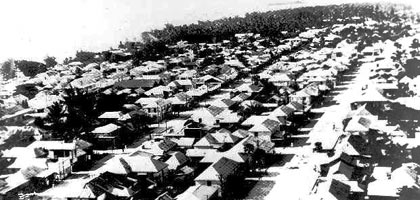

| the expedition | |
| the science | |
| tools & techniques | |
| daily journal | |
| the team | |
| questions & answers | |
|
the islands Saipan Anatahan Sarigan Guguan Alamagan Pagan Agrigan Asuncion Maug Uracas |
|
|||||||||||||||||||||||||||||||||||||||||||||||||||||||||||||||
The Germans and Japanese

The Spanish era ended in 1899 when Spain sold the Northern Marianas to Germany for the equivalent of $4.5 million. The Germans were interested in exploiting the islands' coconuts for oil; however, it was the proximity of the islands to the key shipping routes linking the Western and Eastern hemispheres that was most important.
The period of German occupation would be short-lived, however. At the onset of World War I, Japan forced German settlers off the islands. At war's end, Japan formalized its ownership of the islands. The League of Nations stripped Germany of all its overseas possessions and turned the Mariana Islands over to the Japanese as an administrative territory.
The Japanese virtually annexed the islands and set to work establishing fishing and sugar growing operations. By the mid-1930s, the sugar coming from the Marianas would represent 60 percent of the entire economic output of Micronesia. The populations of the islands swelled as waves of workers arrived from Japan and settled on the islands of Saipan, Tinian and Rota. A population of some 4,000 Chamorro and mixed-race inhabitants at the time the Japanese first arrived would be dwarfed by some 40,000 new immigrants. Chamorro ways faced another survival test as Japanese culture came to dominate the Marianas' inhabited areas. Along with stands of coconut groves and tropical forests, many of the ancient latte stones would fall as ever-increasing swaths of land were cleared to make way for sugar plantations.
In 1935, the Japanese withdrew from the League of Nations but claimed the islands remained part of their empire. The original island culture would be put under even more pressure as nearly 30,000 new Japanese relocated to Saipan. These were not workers but soldiers garrisoned there as the seeds of World War II were being laid.
The following years would see the islands achieve their greatest significance in world history. During the war, one of the Mariana islands would literally be the launching point for a new era of the 20th Century.
